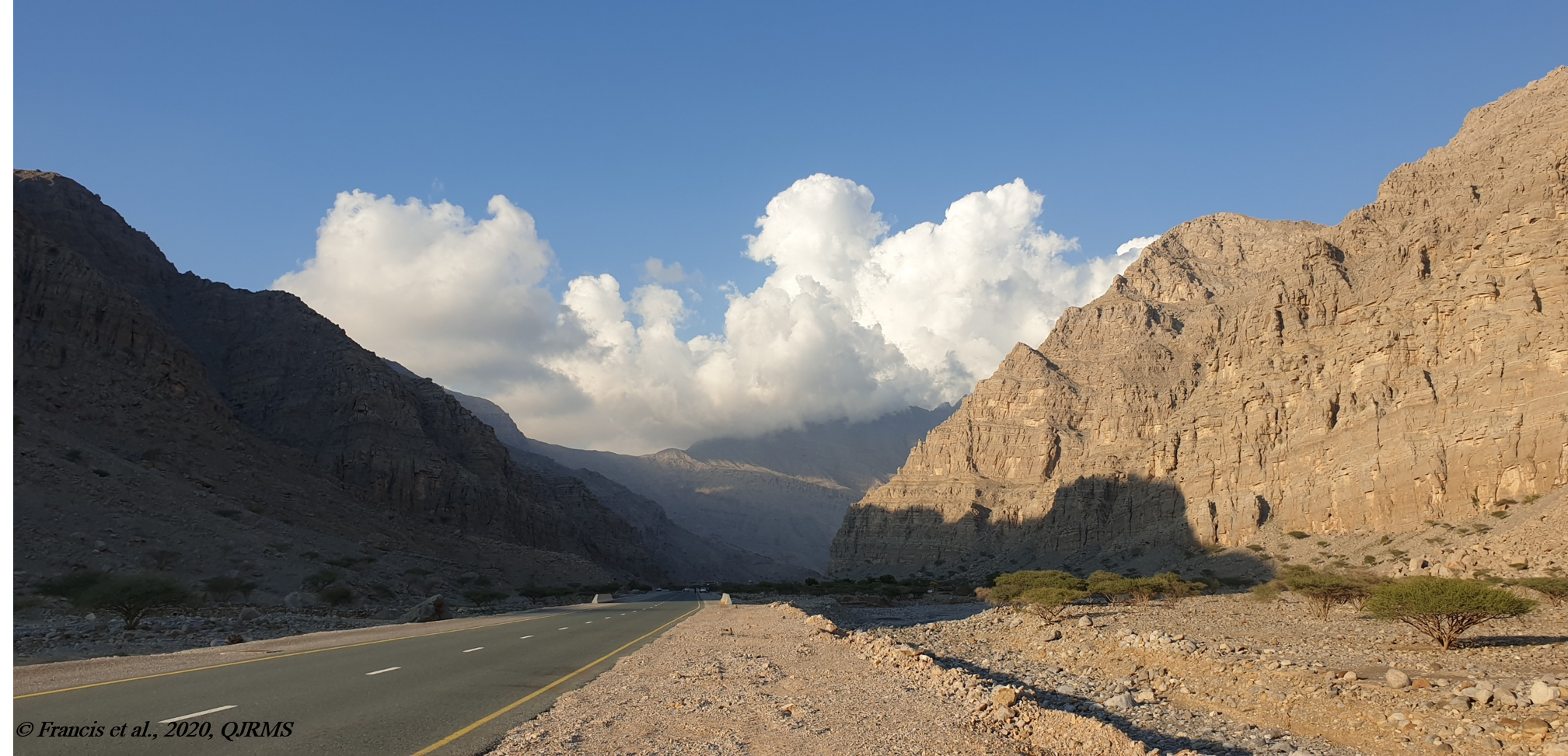
Modelling these rare events can significantly boost the country’s rain enhancement efforts
Read Arabic story here
The UAE is hot and dry, characterized by a landscape of sand and a lack of vegetation. The rains are infrequent and irregular, sometimes with no rain for long periods, making it a hyperarid region.
And yet, despite these factors, the UAE also possesses unique weather systems that can occasionally provide life-giving moisture to rain-starved areas and relief from the excessive heat. These systems are known as mesoscale convective systems (MCSs) and they develop occasionally during summer over the UAE.
Dr. Diana Francis, Senior Research Scientist and Head of the KU Environmental and Geophysical Sciences (ENGEOS) Laboratory, investigated the processes, from local to regional scale, that are responsible for the development of summertime MCSs and associated rains over the UAE. She was joined in this research with ENGEOS team members Dr. Ricardo Fonseca, Postdoctoral Fellow, Dr. Narendra Nelli, Postdoctoral Fellow, Dr. Rachid Abida, Research Scientist, and Michael Weston, Research Engineer, all from Khalifa University, Youssef Wehbe from the UAE National Center of Meteorology, and Dr. Marouane Temimi from the Stevens Institute of Technology. Their findings were published in the Journal of the Royal Meteorological Society.
“For an MCS to develop in a hyperarid environment like the UAE, a combination of factors ranging from local to regional scale is needed,” explained Dr. Francis. “This includes a convergence over the UAE between the northerly wind and the southerly winds in the lower level of the atmosphere, the presence of an upper-level trough in altitude and a steep temperature gradient at the surface between land and surrounding seas”.
“Total annual precipitation in the UAE ranges from 30mm over the southern desert to 120mm over the Al Hajar mountains in the northeastern part of the country,” explained Dr. Francis. “This usually occurs during the cold season from December to March, but every so often, rain accumulations during the summer season are recorded. These are mainly associated with short-lived mesoscale convective systems—a collection of thunderstorms that last for several hours.”
A mesoscale convective system (MCS) is a cluster of storms that moves as a single system. The storms are driven by upper-atmosphere wind patterns and fuelled by daytime heating and an abundance of moisture, typically gaining strength during the day to reach maximum intensity and the greatest potential to produce rainfall in late afternoon. They occur in the tropics around the world and form especially during the hot season. As they weaken and eventually end, they can leave behind a mesoscale convective vortex, which is a system that pulls winds into a counter-clockwise circulation and can become the catalyst for even more storms.
“Despite their minimal contribution to the country’s annual average rainfall, an understanding of the processes that cause MCSs to develop and the capability of numerical models to represent them is crucial for planning cloud-seeding activities,” explained Dr. Francis. “Additionally, summer rain associated with MCSs helps to recharge the underground aquifers, an important water resource for agricultural activity here.”
A better understanding of what causes MCSs in a region known for its aridity and summer heat is an important step towards accurately predicting them and their associated rainfall, especially as recent studies have shown that MCSs are expected to become more frequent as the global climate changes.
On the 5th of September 2017, regional winds converged, bringing warm, moisture-rich air to the Hajar mountains and resulting into the development of a MCS and subsequent rain at Hatta, Masafi and Fujairah airport.
Dr. Francis and her team used the Weather Research and Forecasting (WRF) numerical weather modelling framework to investigate warm season convective events in the UAE. The WRF model was validated using the September 2017 data with the results showing that the model predicted widespread clouds over the Hajar mountains in all simulations, but was not able to reproduce the MCS. The researchers noted the need to properly represent the soil properties for accurate simulations.
“In areas with drier soil, the land is warmer during the daytime,” explained Dr. Francis. “This will naturally lead to a more vigorous sea-breeze circulation, which makes rainfall more likely over most of the UAE.”
The team also found that the WRF model tended to underestimate the observed cloud cover. Consistent with the lack of clouds, the air temperature in the model at night was is lower than the observed temperature, likely arising from enhanced radiative cooling.
“The fact that the MCS, and its impacts on the atmospheric state, are not accounted for in simulations has important implications for the use of the current state-of-the-art models for climate projections in arid regions,” explained Dr. Francis. “Our findings help to better clarify the mechanisms behind the convective events, and understand the signatures of MCSs in a hyperarid environment.”
Jade Sterling
Science Writer
19 November 2020






